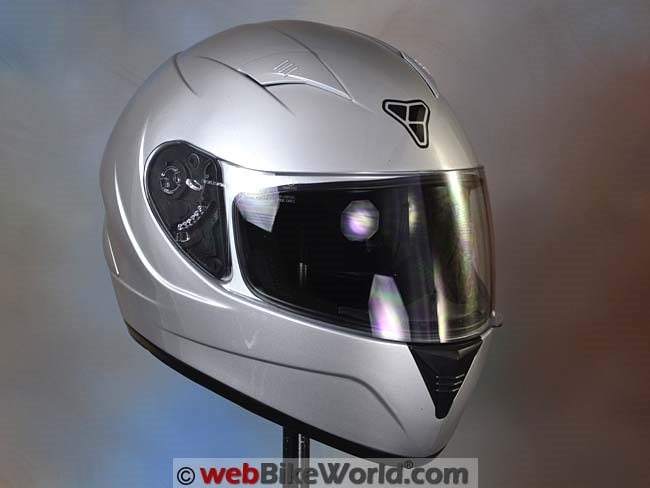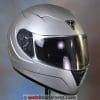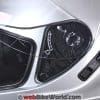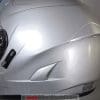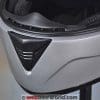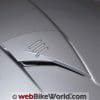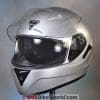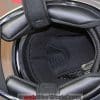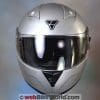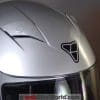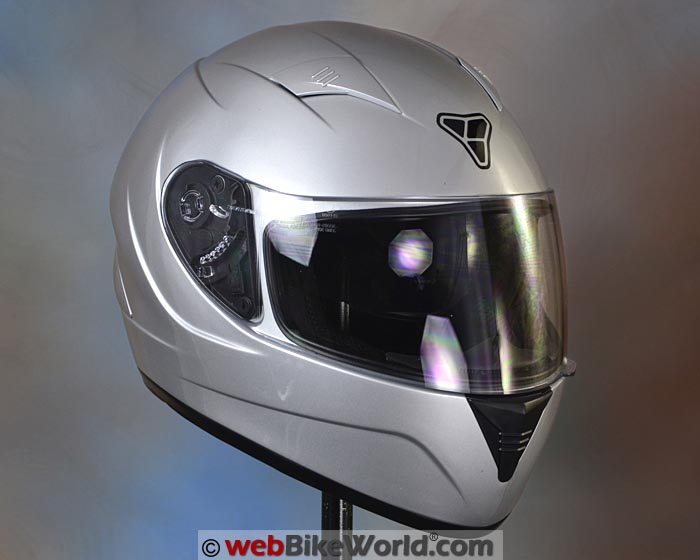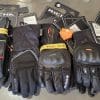“You can’t get something for nothing.” It’s a tired saying but one that is hard to argue with. However, it can be surprising how much you can get for seemingly little.
Over the years we have reviewed helmets from a wide range of price points and have found that a high price doesn’t always correlate to a great helmet. For example, one of our favorite webBikeWorld helmets was the Bell Arrow. That helmet listed for $99.95 and it performed very well, with excellent build quality, low noise, and good comfort.
Is this typical of a helmet for this price? Not always, but once in awhile something like the Bell Arrow comes along. So with that in mind, I hastily unpacked the new Pilot ST-17, with a list price of $100.00 (Special: $83.41 here!). How good is a 100-buck helmet? Let’s see…
Pilot Motorsports
We have reviewed several items from Pilot Motorsports in the last several years, but the brand may not be familiar to some. Pilot started out primarily making custom racing suits for the likes of AMA Pro racing as well as being an OEM apparel manufacturer for companies like Suzuki, Honda and other bike manufacturers and they started a retail line in 2013. We reviewed the Pilot Trans Urban jacket back then and it won a webBikeWorld Motorcycle Product of the Year Award for 2013.
This is important information to be aware of as some riders — like me — might be skeptical of gear from a brand that we haven’t heard of. But knowing that Pilot has been working behind the scenes for years with race level protective gear puts my own mind at ease that they know what they are doing.
In addition to the helmet I’m reviewing here, Pilot also offers textile pants, jackets, gloves and other accessories including, of course, one-piece custom racing suits also.
The Pilot ST-17 Helmet
The ST-17 helmet is the first helmet offered under the Pilot brand and it is a good-looking, if a bit unassuming, full-face helmet. Currently it is offered in four colors: black, matte black, white, and silver as shown here.
With a list price of just $100.00 (Special: $83.41 here), “simple” is the watchword and the solid colors have only the Pilot logo on the front and a DOT/ECE sticker on the rear.
But there are some other interesting features and details, such as the internal drop-down sun visor. While this may not be that unusual in most modern helmets of late, considering the ST-17’s list price, it does start to become intriguing
The Zeus Connection
Something even more intriguing and which also brings credibility to the ST-17 is the manufacturer: Zeus Helmets. Remember them?
We reviewed the Zeus ZS-508 flip-up back when flip-up helmets were first starting to become popular. It had a list price of just $84.00. And Zeus made the Zeus ZS-3000 (review), the very first Snell certified flip-up motorcycle helmetsold in the U.S.A.! Manufacturing a helmet is not a simple endeavor and it typically requires a large amount of machinery and staff, so I assumed that a smaller company like Pilot wasn’t actually manufacturing the ST-17 “in-house” and I was correct.
The label inside the ST-17 indicates that the helmet is manufactured in Vietnam by Gao Jin Industrial, the company behind Zeus helmets.
[UPDATE: The ST-17 is a relative of the ZEUS ZS-810, see the Comments section below. Also, the ST-17 has another relative, the “Goblin” by AXO. See UPDATE 2 below.]Zeus has always made good examples of “Bang for your Buck” helmets. In fact, I personally owned a Zeus 3000 series helmet a few years ago. Gao Jin started making helmets in Taiwan back in 1998 and they create the entire helmet from molding of the shell to paint to EPS manufacture in their own factory. Their own Zeus brand does not appear to be available here in the United States anymore but they still are making helmets under the Zeus brand in other markets.
I wanted to point out this origin for the ST-17 helmet as it is good to know that the factory producing these helmets for Pilot has history in the field of helmet manufacture.
[UPDATE 2: From Pilot Motosport: “Just thought I’d give you a quick heads up as to some of the changes we made to the ST-17 before bringing it to the US market.We spent a good amount of time working with Zeus to modify the product rather than just slapping our name on it. The interior of the helmet was redesigned completely, the materials and overall plushness of it were upgraded over the standard fare. We also replaced the metal snaps on the cheek pads with plastic and had the EPS liner finish changed to black vs. white.
The chin strap on the Zeus 810 was excessively long and featured a quick release buckle that we felt wasn’t up to US expectations. We swapped the quick release for double d-rings and adjusted the strap accordingly.
The biggest modifications came through the safety certification process. We had the helmet tested at three separate facilities, one in house at the manufacturer, one in the country of origin and one state-side in order to obtain ECE and DOT certification.
In order to make the helmet comply with DOT standards we made specific modifications to the EPS liner.
I say all this just to make it clear that although the shell is the same as the 810, the helmet itself does differ in some substantial ways with a lot of time and investment to bring this helmet to market under the Pilot brand name.”]
Paint, Graphics and Overall Quality
The ST-17 uses a shell of injected molded ABS and the helmet feels solid with what I would consider a bit less than average flex for a non-composite shell. It is also free of “creaks” and “squeaks” when made to flex. The glossy silver on this particular helmet looks nice and is well finished for its price.
The clearcoat is smooth and defect free, but it is not very thick or “deep”, but considering the price point, one shouldn’t expect metalflake or a thick, highly polished finish. Still, the paint is not flawed and overall I would say it is very good.
The face shield operation is slightly stiff, with very noticeable detents and a final detent that takes a deliberate shove to open fully. The stiff detents causes the face shield to flex as it’s being opened, which cheapens the feel a bit. The mechanism for opening and closing the internal visor I would rate as average for smooth operation.
Score: I give the overall quality between average to above average but very impressive considering the $100.00 price. See the Summary Table at the bottom of the page for a description of our rating system.
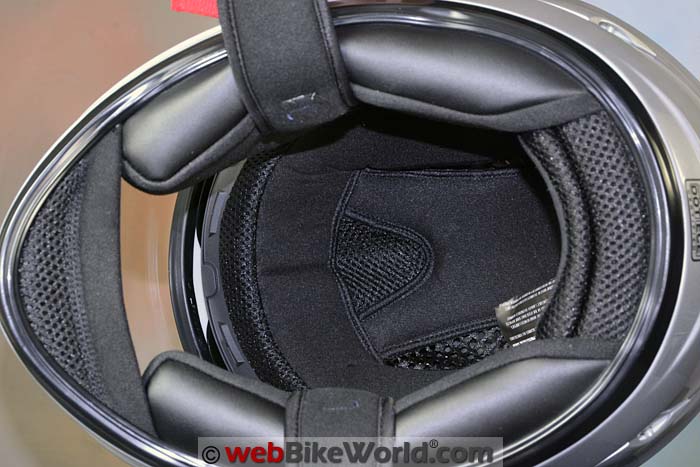
ST-17 Internal Shape, Fit and Liner Notes
Internal Shape
The ST-17 has what I would characterize as a “Neutral” to “Slight Narrow” internal shape. The shape works around the sides and top of my head, but the chin bar is a bit closer than I would prefer. The shape reminds me very much of the Nolan N86 (review).
Another similarity is that the both of those helmets don’t quite come down past my jaw so my lower jaw and upper neck area feel a little more exposed than I’d like.
Helmet Fit
The ST-17 fits very much like I would expect a size large to fit me. For comparison, I’m a size large in most Shoei, Shark, Caberg and HJC helmets. Fresh out of the box, the padding in the ST-17 provides a nice snug fit for my intermediate oval head.
The cheek pads are a bit stiff and are the tightest point on my head when wearing the ST-17, but this is also a brand new helmet; over time the padding should break in and not be as snug. I actually prefer a slightly too snug feeling in a new helmet since I know it will break in later and will be comfortable but still hold itself in place.
Except for the chin bar being a bit close to my chin for my head shape (for which I cannot fault Pilot), the overall fit is actually very good.
In fact, it feels like it is putting more even pressure all around my head than most other helmets I’ve worn, which gives a very secure feeling.
Of course this is specific to my head so not everyone will feel the same.
Eyeglass Fit
I typically wear contact lenses when riding but for this review I got out my prescription glasses for a quick fit test and even though Pilot doesn’t call out eyeglass compatibility, I found my glasses fit in the helmet quite easily.
There is enough space to allow them to settle on my ears and nose as they should, but of course, each head shape and the style of eyeglasses will affect this.
To be thorough, I tried some sunglasses as well as a pair of reading glasses I had on hand (do not ride in these!) and clearance was good on the various frames.
Intercom and Speaker Fit
The ST-17 will prove to be a challenge to fit an intercom and speakers, because there are no speaker pockets or cutouts present in the space where the ears rest in the helmet. There is a thin layer of liner material for the ear pocket but behind it is a thin layer of plastic that sits between it and the EPS foam.
Very small speakers like those found on early Cardo units might fit there if glued on the plastic, but larger speakers like on my Sena 3S (review) will be too large and press against the ears.
Liner Comfort
I’ll come right out and say I wasn’t expecting much in the way of a plush or “cushy” liner from a helmet at this price point. But while the ST-17 doesn’t have the most plush liner, it is perfectly fine and the surface is smooth and not scratchy-feeling at all. The padding is a bit stiff however, as it is for the cheek pads, but it should break in over time.
The liner and cheek pads are easily removed from the ST-17 for cleaning and replacement. Plastic snaps similar to those used in most helmets hold them in place and they connect and remove positively.
Pilot does offer replacement liners and cheek pads (unusual at this price), so the helmet can be easily customized for fit by mixing and matching the parts. Since Pilot only uses one shell size for the ST-17, there is no need to worry if certain size pads will fit a specific size helmet.

More information on helmet fit can be found in the webBikeWorld Motorcycle Helmet FAQ page. Also, see the chart that lists the helmet weights of webBikeWorld reviewed helmets and also by shape on the webBikeWorld Motorcycle Helmet Shapes page.
Score: The ST-17 again splits the difference between Average and Above Average and the snug fit that works well (for me) is above average compared to what I have experienced.
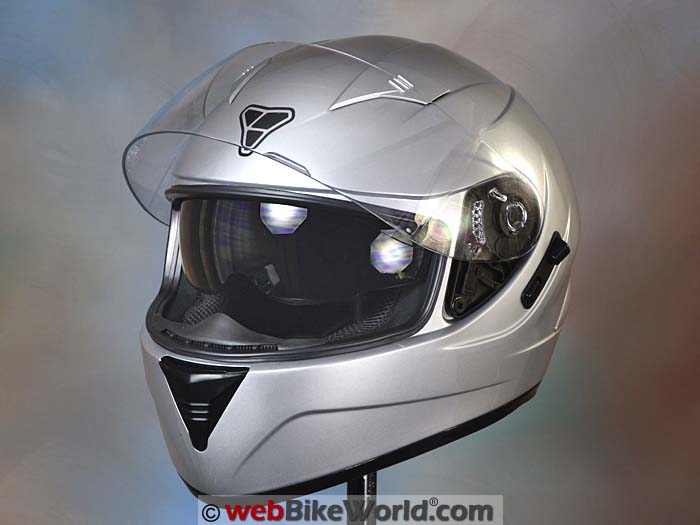
Face Shield, Eye Port and Outward Visibility
Eye Port
The eye port on the ST-17 is a bit smaller than most other helmets I’ve worn in the past. The side-to-side visibility is just about average in my opinion but the top to bottom distance seems pretty narrow.
There is a sort of a bonus to this, however, because the lower vertical height of the eye port can be used to block the morning or afternoon sun by tilting the head slightly, a problem I had with my old Shark Vision-R GT-Carbon helmet.
Face Shield
Optically, the main face shield on the ST-17 is very good. Considering the price, I was expecting and willing to accept that some distortion would be noticeable through the polycarbonate visor. But I’m pleased to say that this wasn’t the case and what distortion is visible is very minimal and I didn’t really notice it until I went looking for it in the course of the review.
The same optical clarity is present in the internal sun visor also. The face shield is 2.3 mm thick (about average for a motorcycle helmet). As I noted earlier, the detents for each open position for the face shield are quite firm, which can induce flexing when lifting or closing.
This is more noticeable when using the fully wide opening as it requires a deliberate shove upward to click into place.
Overall I am pretty pleased with the face shield but I would appreciate a smaller initial opening point for de-misting, although this lack of a small first defogging position seems to be pretty common among the helmets I’ve seen lately, which is a shame, as it is a useful feature
Face Shield Removal
Pilot uses a tool-less design for removing and replacing the face shield and it is of course different from any other helmets I’ve encountered.
(NOTE: See the extended face shield removal and replacement procedure illustrated in our video below.)
Removal is relatively easy but takes a bit of practice, as this is not a quick one-lever remove and replace. It requires that you open the visor to the second highest point, then slide open a small plastic “gate” which is now accessible with the face shield in this position. Once these are opened, it becomes easy to position the detent slider so that it slips out of the gate. With that slider free, reposition the face shield so that the tabs on the pivot point line up with the cutouts surrounding it for the face shield to come free.
If you’ve worked on motorcycles or cars for any length of time, you’ve probably read the phrase “Installation is the reversal of removal” or something similar. While it is true that reversing the removal process should install the visor, there is a little bit of attention required. The attention is important because it can seem like putting the shield back on is incredibly difficult.
It turns out Pilot did something clever to make it easy to get the shield in place and I’ll admit it took me a few tries before I realized it. Looking at the tabs on the pivot points makes it appear that they need to be lined up for both the left and right sides at the same time.
Trying to do this will drive you crazy, though you might get lucky and have it slip into place, but you may not be sure why.
As it happens, Pilot must have considered that it would tricky to line up both sides so the shield is designed to fit one side at a time. First you insert the left side and then lower the shield slightly, which locks that side into place. Then the right side will line up, allowing it to be inserted into the pivot.
After that the detent “pin” can go back into its track and the release gates can be closed. After realizing that both sides don’t go in at the time, the re-attachment process became easy. Again, this may sound complicated but once you see it illustrated in our video below, it’s fairly straightforward.
Face Shield Eye Port Gasket Sealing
The face shield doesn’t seem to make solid contact with eye port gasket, at least with this particular sample. Since it can be difficult to really tell sometimes how well the face shield seals, I gave it a practical “leak down” test. Using a low pressure on my kitchen sink sprayer, I held the sprayer over the helmet and let the water rain down onto the area along the top of the face shield. Sure enough, water ran down the inside almost as much as it did on the outside.
Note that it is usually possible for the owner to adjust this by slightly loosening the screws in the side plates that hold the face shield rotating mechanism and then adjusting the side plate to create a tighter seal.
Internal Sun Visor
The ST-17 has an internal sun shade visor that retracts up into the shell when not in use. Raising and lowering is handled by a large rocker-style button on the left side of the helmet. The mechanism moves with deliberate pressure required for both raising and lowering and there is a strong “thunk” as it reaches the end of travel.
Due to the nature of the mechanism, it is not really possible to position the visor anywhere but fully up or down.
The lowered position doesn’t come down as low as I would like and there is a noticeable gap between the bottom of the visor and my outward vision, so I would prefer it dropped another 12 mm or so (1/2″) to keep the edge out of view.
On the plus side, the sun visor seems to be darker than most that I’ve used. While I might not call it a true “Dark Smoke”, it is still dark enough to be very helpful in bright sunshine.

Score: I’ll give the ST-17 an overall “Average” rating for the visor and eye port areas.
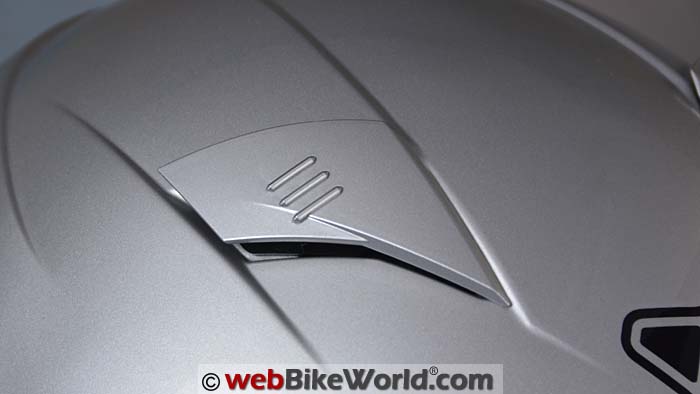
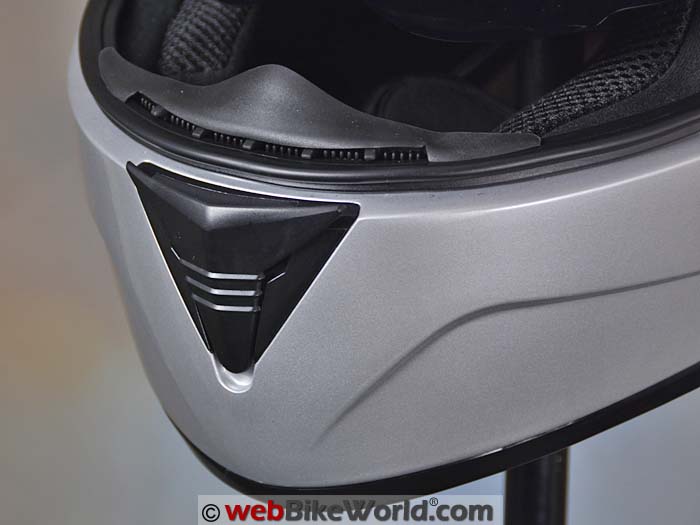
Ventilation and Air Flow
Top Vents
Ventilation through the top vents is minimal but I can feel it once I get over 35-40 mph, so I’ll rate the amount of air flow as about average compared to most of the motorcycle helmets I’ve worn over the years.
The two top vents have a sliding closure with three raised lines on top for grip when wearing gloves. They’re a bit stiff to open and when closed, the covers wiggle around a bit.
Closing or opening these covers doesn’t seem to change the meager air flow in the top that much but I could see a little light when shining a flashlight from the interior to the outside so there is a clear path from the outside into the liner.
Chin Vent
The chin vent hits the average mark and the air is directed only along the top of the chin bar and at the face shield. It does a good enough job of defogging but there are no ventilation holes through the chin bar. However, overall ventilation in this area is still pretty good due to the the fact the shell barely covers below my chin and the included chin curtain is relatively small.
This allows air to flow up into the face well enough that I didn’t miss it from the chin vent.
Like the top vents, the chin vent has a sliding cover with a similar surface design. This vent opens and closes with a better feel than the top vents and it seals better when closed.
Exhaust Vents
There are three vents at the rear of the ST-17, with two sitting low on the left and right rear of the helmet and a central one at mid-height in the center. I couldn’t exactly determine where the two side vent channels begin on the inside through the EPS at first, but after digging around and blowing into the vent from the outside, I found there is an opening right where the rear of the cheek pad meets the rear neck roll.
I used a flashlight shining from the outside and it was very visible in the inside at these vent points, which demonstrated a relatively direct channel to these vents.
I also used the same technique on the screened rear vent, which revealed where the center rear vent opens into two holes in the rear of the EPS towards the top.
Chin Curtain
The included chin curtain is narrower than some and it’s about 44.5 mm (1-3/4″) at its widest point. The curtain sits a bit high and I can easily touch it with my chin, which is more of a reflection of the shell design than the curtain itself.
The material used is a combination of mesh and sold textile with plenty of stretch. The curtain is removable for those who prefer to not use it.



Score: Overall the venting on the ST-17 is what I would characterize as average compared to most other helmets.
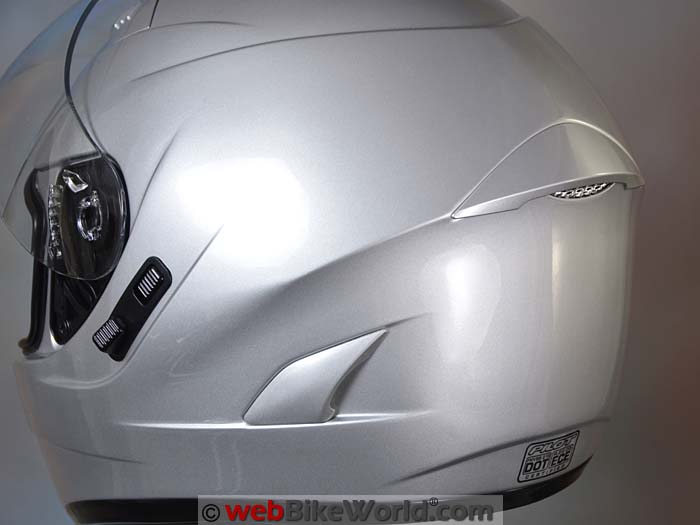


Noise Control
I’ll say it right out of the gate here, the ST-17 is a quiet helmet. I’ll admit the price factor was in my head before I went out for my first ride with the ST-17, so I wasn’t expecting much and I was very wrong. In fact, the ST-17 is a quiet helmet — one of the quietest I’ve worn.
Noise that is present is mostly wind rushing by the sides with very little, if any, booming or low frequency sounds, although I was able to generate a faint whistle above 40 mph. It is important to point out that I had to work at it to find a position to actually create that whistling noise, compared to some helmets where it’s just the opposite — trying to find a sweet spot for the noise to go away.
Nevertheless, I didn’t find the faint whistle to be a problem or a distraction; if I wasn’t being very detailed for this review, I don’t think it would have even stuck in my mind.
I used all three positions of my Kawasaki Ninja 1000 (review) windscreen with the lowest and middle settings showing no difference in overall noise levels when I was wearing the ST-17.
Even the highest windscreen position only induced a little more noise, even at highway speeds. This good performance makes sense considering how stable and smooth the helmet feels at speed.
Pilot (Zeus) obviously spent time designing the ST-17 to flow through the air in a smooth manner.



Note that our helmet evaluations are a combined effort of several riders over time on different types of motorcycles with and without windscreens. Evaluators wear correctly fitted, high quality ear plugs (even when evaluating motorcycle intercom systems).
Always protect your hearing when riding a motorcycle. See the wBW Earplug Reviews for more information on choosing and wearing earplugs. Note also that perceived noise levels will vary, depending on the individual.
Noise can be caused by many factors, including helmet fit, the type of motorcycle and windscreen, wind speed and direction and even the rider’s clothing. For more information on helmet noise, visit the wBW Motorcycle Helmet Noise page.
Score: We’ll give the ST-17 a “Very Good” rating for noise control.
Video: Pilot ST-17 Helmet
See the rest of our videos on the webBikeWorld YouTube Channel.
Helmet Weight
The ST-17 in size large tips the scales at only 1597 grams, which is a good showing for any helmet full-face helmet that includes an internal sun visor. This number puts it in pretty good company, with helmets like the Arai RX-Q (review) at 1597 grams, also in size large and the Arai Corsair V Nicky 5 (review) at 1598 grams, also a size L.
The ST-17 also excels with a very balanced feel making the helmet feel lighter than it is and it cuts a very smooth path through the wind at highway speeds. The helmet feels smaller than its actual size and head checks or simple turning of the head at speed resulted in no helmet lift and very little buffeting.
Note that all of the helmets reviewed on webBikeWorld have been weighed and the weights are available on the wBW Motorcycle Helmet Weights page. See also the chart that lists the helmets by weight and shape on the wBW Motorcycle Helmet Shapes page.
Score: We rate the ST-17 as “Outstanding” for its very low weight and good balance and aerodynamics.
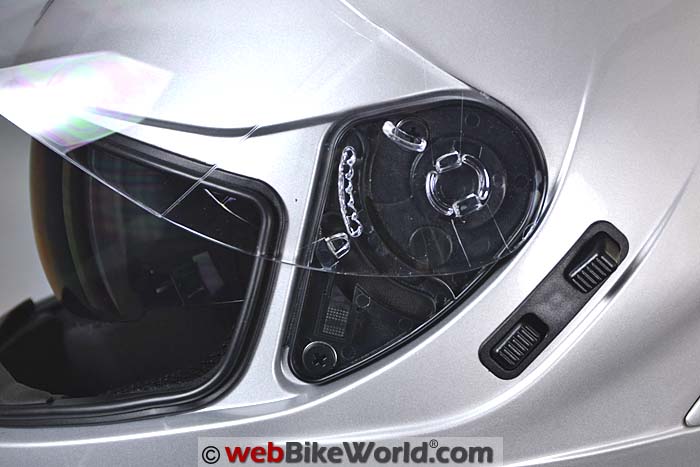


Miscellaneous
The ST-17 meets both the DOT standard in the USA and the European CE 22.05 standard. See the webBikeWorld report “ECE vs. DOT Helmet Safety Standards” for more information on the difference between DOT and Snell.
ST-17 uses one shell size to span the head sizes range of XS to XL only. The helmet has a 2 year warranty “in case of premature failure or manufacturer defects.”
Conclusion
The Pilot ST-17 leans towards the positive for overall quality and real-world performance, especially considering the price. The vent sliders on top are something that could be improved with an updated design but overall they do not have a negative effect on the helmet.
The gasket seal around the eye port needs improvement and it shouldn’t be up to the owner to have to try and adjust this by moving the side plates. The ST-17’s liner and padding is good, if not plush and the internal sun visor is nicely tinted and the mechanism is solid.
What Pilot has done is prove that an inexpensive helmet can match much more expensive helmets on their own level or even better when it comes to fit and shell design.
The ST-17 feels lighter than its actual weight would indicate, which is also very good. The helmet is also quiet and the design keeps it very stable at speed and it shows no tendency to lift when looking behind for a lane change, even at interstate speeds.
In fact, I think the ST-17 does better in this area than my most recent helmets, the Shark Speed-R and Shoei GT-Air (review). At the current list price of $100.00, the “cons” can be overlooked and overall, the ST-17 is a good, solid helmet. It makes me curious what Pilot could come up with if they shot for the $200.00 or $300.00 price point? Maybe they will!
Owner Comments and Feedback
After one ride I can feel it breaking in and it is getting comfortable. The helmet feels very light while wearing it. Sort of forgot I had it on. For the $87 I paid I guess I can’t complain so I will be keeping this helmet. As long as you don’t ask too much of this piece of kit I think it is a great deal. I hope these comments will be helpful.”
From “L” (April 2017): “Just received my Pilot ST-17 Helmet after reading the review on this website. The good stuff: I took it out of the box and it appears to be nice piece of kit. The paint is smooth. The fit is a little tight but I believe it will break in nicely. I practiced taking the face shield on and off a few times and the procedure is not hard to master. Just takes a little practice.
The bad stuff: The air vent covers are REALLY hard to operate especially with gloves on. They stick and feel ridiculously CHEAP ( even for an $87 helmet). If I keep the helmet I guess I will just leave them open. If I keep the helmet I will share more info after my first ride with it.”
From “A.G.” (March 2017): “The Pilot ST-17 is the ZEUS ZS-810 (Zeus website page) ODM version. The ZS-810 usually sold by brand vendor, not manufacturer brand. For example, this model made for AXO-810 early (is the) ZS-810. Changing the face shield, I suggest “do it two side in same time” (here is a YouTube video): ZEUS ZS-1200E Helmet Shield Quick Release.


